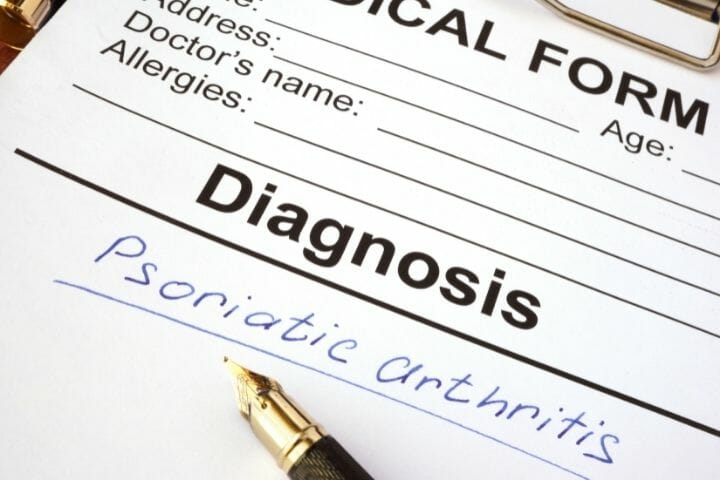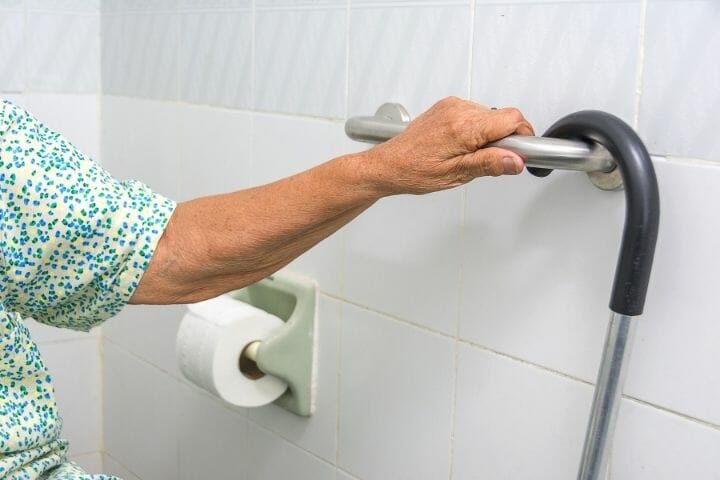Arthritis is a very common disease in old age, but still, a lot of people do not understand how to care for an arthritic person. This guide will help you understand everything you need to know about taking care of someone with arthritis.
Contents
Does your loved one above the age of 65 feel pain while grabbing something from the shelf? Or do they have any bit of swelling every time they go out for a little walk to the nearby grocery store? If they do, then most likely, they are suffering from arthritis.
Around 24% of all adults in the US have arthritis. But the stats are even scarier when talking about seniors: about 1 in 2 seniors above 65 have this disease.

However, the impact of arthritis on every person is not the same. It could be mild aches and pains for some, while for others, it could be so severe that they have to limit their daily activities.
The most common forms of arthritis are joint pain, stiffness, and swelling in the knees, back, and hands. Different types of arthritis impact differently. In this article, let us look at
- Different types of arthritis, its symptoms, and causes.
- How can caregivers help seniors with arthritis pain?
Different Types Of Arthritis
To find the best treatment for arthritis in seniors, you need to know which type of arthritis they are suffering from. Let us look at the most common types of arthritis and their symptoms.
Osteoarthritis
Osteoarthritis(OA) is the most common type of arthritis people get affected with. It impacts the joints, including your bones, ligaments, muscles, and cartilage. OA mostly happens to older people but can also be due to injury or obesity. It occurs due to the wear and tear of the joints.

Osteoarthritis can occur in any joint but commonly occurs in the hands, knees, hips, and spine. Its symptoms are manageable, but you cannot reverse the damage to the joints. It is best to consult a doctor if the joint pain becomes unbearable.
Older people suffering from Osteoarthritis should stay active, maintain a healthy lifestyle, consult their doctor regularly, and get the treatment done to slow the progression and help improve joint function.
Symptoms
The symptoms of arthritis may develop or increase over time. The symptoms include signs such as:
- Pain. People may feel pain in the joints while moving.
- Tenderness. When you apply slight pressure to the joints, you may feel some tenderness.
- Not able to move freely. You may not be able to move your joint as you used to earlier. Your range of motion reduces.
- Stiffness. You may feel stiffness in your joints when you are not active for some time.
- Swelling. You may find some swelling due to soft tissue inflammation around your joints.
- Bone Spurs. Sometimes people get hard lumps around the joint known as bone spurs, which is also a symptom of arthritis.
Causes
OA occurs when there is a gap between the cartilage and worsens over time. Cartilage is a type of soft tissue around the joints that helps the joint to move freely without any friction.
When the cartilage wears out, the bones start to rub against each other, causing pain and discomfort. This rubbing affects the entire joint area and leaves swelling or inflammation around the joint.
Risk Factors
Let us look at some factors that may increase the risk of Osteoarthritis.
- Old age. The risk of OA increases exponentially with age.
- Obesity. Overweight people are at a greater risk as it adds more stress and weight to the joints, thus worsening the pain.
- Joint injury. If you play a particular sport and put pressure on joints, the pain may worsen over time.
- Genetics. Some people may tend to get Osteoarthritis due to genes.
- Bone Deformities. People with some joint issue or defective cartilage are at significant risk of Osteoarthritis.
- Sex. Women are more prone to develop osteoarthritis than men.
Rheumatoid Arthritis
Rheumatoid Arthritis (RA) causes joint pain and inflammation. It starts by attacking the healthy tissues in the body, then slowly damaging the other body parts.
So if you have joint pain in one side of your leg or arms, the other side may also get affected over time. If people suffer from this type of arthritis, it is better to consult the doctor and get the treatment done the earliest.

Symptoms
The symptoms of rheumatoid arthritis mainly affect the joints in your hands, knees, and wrist. It may also affect your body’s tissues and organs, including your heart, lung, and eyes.
The most common symptoms of RA include:
- Pain, Swelling, And Stiffness. People may feel some pain and stiffness in their joints, including their hands, knees, shoulders, wrists, and elbows. It may get affected in multiple joints.
- Pain In More Than One Joint. People may feel pain in joints, wrists, and hands.
- Some Kind Of Stiffness In the Morning. People may notice some kind of stiffness in the body that may last for a long time. Loss of appetite and fatigue may also be there.
Symptoms can be mild or severe. People shouldn’t ignore any of these signs and get the treatment done as early as possible.
Causes
The specific cause of RA is not known.
The immune system makes antibodies that fight back bacteria and viruses present in the body and help fight the disease.
But if you suffer from RA, your immune system sends these antibodies to the lining of the joints, thus destroying the lining cells and leading to inflammation. This may further damage the bones, ligaments and cartilage, and tendons.
If it is left untreated, the pain will worsen over time. The joints will gradually start losing their shape and alignment, thus damaging the joints completely.
Risk Factors
- Age. The risk factor of RA is highest among people in their 60s. The pain may get worse as people age.
- Sex. RA is three times more in women than men.
- Genetics. People with specific genes are more prone to getting RA. People with HLA class A genotypes are primarily prone to rheumatoid arthritis and may worsen over time. People who smoke or are obese are at greater risk of RA.
- Smoking. As per some studies, smoking increases the risk of developing RA and worsens it.
- Obesity. The more overweight a person is, the more he is at risk of developing RA.
- Diet. People who consume meat, sugar, and iron are at a greater risk of developing RA.
Gout
Around 3.9% of people in the US have Gout. Gout is formed when uric acid and crystals get built up in the joints. You will find that the joints get inflamed all of a sudden. Sometimes it can affect many joints simultaneously.
When someone experiences gout symptoms (such as flares), it usually starts suddenly and can last for a few days or weeks.

Symptoms
The symptoms of gout occur all of a sudden and usually at night. They include:
- Inflammation and Redness. The joint that gets affected is swollen, warm, red, and tender.
- Limited Mobility. If gout progresses, people will find difficulty in moving their joints as usual.
- Severe Joint Pain. Gout mostly affects the big toe, and pain in the joint can occur all of a sudden. Gout can also occur in the ankles, knees, wrists, elbows, and fingers.
- Presence Of Tophi. Another symptom of anyone suffering from gout is tophi. Tophi is like a bump or hard nodule that comes out from the skin. It occurs in elbows, wrists, or fingers.
Causes And Risk Factors
Gout is caused due to accumulation of uric crystals in the joints, usually the big toe. These crystals get formed when the uric acid in the blood is high. Uric acid is found when the body breaks down purines found in the body. It causes swelling and inflammation and causes intense pain.
Uric acid usually gets dissolved in the blood and is passed from the kidney through urine. But sometimes, the body produces too much uric acid, or the uric acid passed from the kidney is too little. When this happens, it causes pain and swelling in the joints.
Risk Factors
- Weight. People who are overweight are at high risk as more uric acid gets produced.
- Medications. One of the main risk factors of gout is having high BP, diabetes, heart and kidney diseases. Certain medications that people have to control hypertension may also increase the uric acid in the body, causing gout.
- Diet. Drinking beverages that are sweet and having food like red meat and shellfish increases the uric acid level. This further increases the risk of gout. People who consume beer are also at significant risk of gout.
- Sex. Gout mainly occurs in men between the age of 30 and 50. Women will usually develop the symptoms of gout after menopause.
- Surgery Or Trauma. Gout may occur after surgery or trauma. When people receive a vaccination, they may feel a gout flare in the joints.
Psoriatic Arthritis
Around 30% of people in the US have psoriasis. It is an inflammatory disease and causes redness or rash in the knees, elbows, ankles, hands, and feet. It occurs when the body’s immune system affects the soft and healthy tissues mistakenly.
Psoriatic arthritis primarily affects the skin and joints and makes them tender, swollen, and painful. It is advisable to get the treatment done at the earliest. Otherwise, it may damage the joints and tissues in other parts of the body.

Symptoms
This autoimmune disease can get worse over time. It can affect one or more joints in the body. Usually, the joints are painful, inflamed, and warm to the touch. Other symptoms include:
- Foot Pain. Some people may have pain in the joints, usually where the tendons and ligaments connect.
- Back Pain. People may have pain in the lower back and develop spondylitis, a sign of psoriatic arthritis.
- Damage to Nails. You may find some dents in the nail, or it may get crumbled or separated from the nail bed.
- Swollen Fingers and Toes. Swelling in the fingers and toes is painful.
- Eye Redness And Pain. Many times uveitis causes redness, pain, and blurry vision. If left untreated, it can also lead to vision loss.
Causes And Risk Factors
Psoriatic arthritis happens when the body’s immune system affects the body’s tissues, causing pain and inflammation in the joints.
Both genetic and environmental factors can cause it. People who have psoriatic arthritis may have a family history of the disease.
Certain environmental factors such as viral or bacterial infections that affect the immune system are also one of the causes of this type of arthritis.
Risk Factors
- Psoriasis. It is one of the main risk factors that cause psoriatic arthritis.
- Genetics. Some people may have a high risk of developing psoriatic arthritis if any of the family members suffer from it.
- Age. People can get psoriatic arthritis at any age, but it usually occurs in people between ages 30 and 60.
How Can Caregivers Help Seniors With Arthritis Pain?
Family caregivers are of great help for seniors with arthritis pain. They can connect and coordinate with their health care team, physical therapist and help improve the living environment and maintain a healthy lifestyle. Let us look at ways that caregivers can help seniors with arthritis.
Coordinate With Doctors And Other Healthcare Team
Seniors with arthritis may find it challenging to coordinate with their doctors, physical therapists, and pharmacists regularly. It is essential to inform the healthcare team if they find any changes or pain in joints.
It is necessary for a family caregiver to be in touch with the health care team and help the seniors with the exercises and medications that their doctor recommends. Family caregivers can set reminders, plan routine schedules, support and guide the seniors at home.

Modify Your Home
A caregiver can help their seniors by modifying their home to live a safe and comfortable life. You can reorganize and change minor things, so it is easy for seniors with arthritis to reach things for which they would otherwise have to bend, twist or kneel, thus reducing the strain and risk of falling.
Let us look at a few ideas:
- You can place the kitchen utensils at a standard height instead of in an overhead or under the kitchen top, so they are easy for seniors to pick up and don’t require them to bend or stoop.
- You can also buy utensils that are easier to hold. There are spoons, knives, and forks that are specially designed with a wide grip so that they are easier to hold. Some are designed in a bent shape so that you don’t have to twist the hand while eating.
- You can buy taller chairs or stools (or even increase the height of the chairs already there), so the seniors don’t have to bend a lot and sit comfortably for a long time. You can also buy higher toilet seats so that they can comfortably sit down in the toilet.
- You can place non-slip mats in the bathroom with railings. This will make it easier for them to grab onto something when they are bending or getting up, and the mats will protect them from falling.
- You can install a walk-in bathtub or a transfer bench for easier access to the tub. This way, seniors do not have to jump over the edge of the bathtub to get in.

Healthy Diet
Having a healthy diet can lead to a better life for all of us. You can take the advice of your medical professional to understand which foods can have a beneficial impact on your seniors’ arthritis.
The doctor primarily recommends having a diet rich in fruits and vegetables and will advise cutting down on processed and sugary foods. They may advise them to avoid certain foods that can increase the pain.
At the same time, you need to make sure that they maintain their weight because higher weight puts more pressure on the joints, which can increase pain.

Exercise And Physical Activity
Along with a healthy diet, exercising every day makes a lot of difference in the lifestyle of the people. Depending on which part of the body is impacted by Arthritis, seniors can do some moving and stretching exercises that will help strengthen their muscles.
When you start with some exercise and find it helpful, you will stick to it. It will further help ease out the joint pain over time. It is advisable to talk to your doctor or physical therapist before starting any exercise or stretching activity.
It is important to tell them about any injury or balance issue they may be facing. Some doctors may suggest swimming, yoga, walking, and other gym workouts.
Watch exercises that may help reduce joint pain in arthritis:
Listen And Empathize
Often, you will find seniors with arthritis pain may feel depressed and anxious and become socially withdrawn. They may sometimes even get angry and feel helpless due to their physical condition.
As a caregiver, it is essential to listen and empathize with seniors with joint pain. Keep an open mind and be willing to listen to their feelings and needs. Sometimes seniors may not find it comfortable to talk about their pain and comfort and share any information.
One best thing you can do is just be present in front of them and talk to them. You can ask them how they are feeling and if they fear anything.
You can help the seniors join some arthritis exercise groups or self-help groups, take them to their religious places and meetings and spend as much quality time as you can.

Don’t Be Afraid To Help Seniors With Arthritis Pain.
It is essential for people with arthritis to learn the best ways to manage the pain. Though arthritis pain cannot be cured entirely, you can reduce the pain and swell with proper and timely treatment.
Caregivers can love and support the seniors with arthritis pain and improve the lifestyle of the people while maintaining a healthy diet.
We hope this guide has armed you with enough information about Arthritis, its causes, effects, symptoms, and how you can help someone with this disease. If you have more questions and doubts, do reach out to us in the comments section, and we will try to answer them for you.
If you liked the content, please share it with those who are suffering from this disease or are caring for patients like you.
